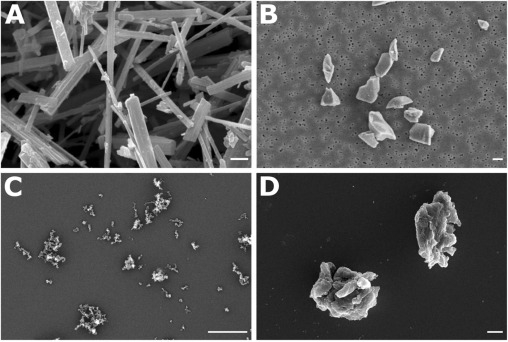From properties to toxicity: Comparing microplastics to other airborne microparticles

Properties such as size, shape, and surface characteristics of microparticles influence their potential hazard to humans.
Researchers at the University of Bayreuth want to find out the consequences of inhaled microplastics. In order to better understand these, they have worked out the connections between the health hazards of particles such as soot, sanding dust or asbestos, for example, and their physical properties in an interdisciplinary study. By making comparisons with the properties of microplastic particles, more accurate statements can thus be made about their potentially hazardous effects on health.
Microplastics are found everywhere in the environment, including in the atmosphere. As a result, we constantly inhale microscopic plastic particles in our everyday lives. If these enter the respiratory tract, they can potentially be harmful to health. However, there are not yet enough scientific studies to reliably assess the dangers posed by microplastics in the air. In a review article, a research team coordinated at the University of Bayreuth has now compiled knowledge about the already well-studied health hazards of various microparticles and compared them with the properties of microplastics in order to identify potential hazards of microplastics.
The interdisciplinary team led by Bayreuth microplastics researchers Prof. Dr. Holger Kress and Prof. Dr. Christian Laforsch focused on microparticles such as asbestos, soot particles from car exhausts, or dusts produced by sanding wood or stone. The authors from the fields of physics, biology, biochemistry, medicine and nano-sciences paid particular attention to the role of physical and chemical properties of the particles in their toxicity. Parameters such as the size, shape and surface charge of the particles, as well as their persistence in the lungs and bacteria and biomolecules adhering to the particles, can influence their hazard potential. For example, long fibers are often more hazardous than compact particles because long fibers are more difficult for the body to eliminate due to their shape, allowing for permanent inflammation in affected tissues. As a result, such fibrous microparticles can be carcinogenic, which has long been known for asbestos, for example.
If the significance of the physical and chemical properties for the health effects of the microparticles is known, potential hazards of microplastics to human health can be identified earlier, the scientists said. "This knowledge allows us to identify important unanswered questions about the hazard potential of microplastics. As a result, we can contribute to targeted research and faster assessment of the risk of microplastics to humans," explains Prof. Dr. Holger Kress, initiator of the study and Professor of Biological Physics at the University of Bayreuth.
"With our work, we are helping to understand the fundamental mechanisms behind the health effects of microparticles. Much of what is already known for other microparticles may also be applicable to microplastics," adds Simon Wieland, first author of the paper and a doctoral student at the University of Bayreuth. Therefore, he says, it is important to benefit from this knowledge to enable a rapid assessment of the risk of microplastics in the air we breathe.
Now it is important to bring the newly gained knowledge to bear, he said. "There are still many unanswered questions about the physical and chemical properties of microplastics. Microplastics are not all the same, but are made up of many different particles with different chemical compositions, surface properties, shapes and sizes," says Prof. Dr. Christian Laforsch, spokesman for Collaborative Research Center 1357 Microplastics at the University of Bayreuth and holder of the Chair of Animal Ecology I. That is why it is now of great importance to take this diversity into account in toxicological research. Only in this way can the effects of microplastics on humans and the environment be comprehensively understood, the researcher concludes.
Original publication: Journal of Hazardous Materials - Wieland et al. (2022). Comparing microplastics to other airborne microparticles
Source: chemie.de: Von Staub lernen: Gesundheitsgefahren von Mikropartikeln verglichen
Image source: Journal of Hazardous Materials - Wieland et al. (2022). Comparing microplastics to other airborne microparticles